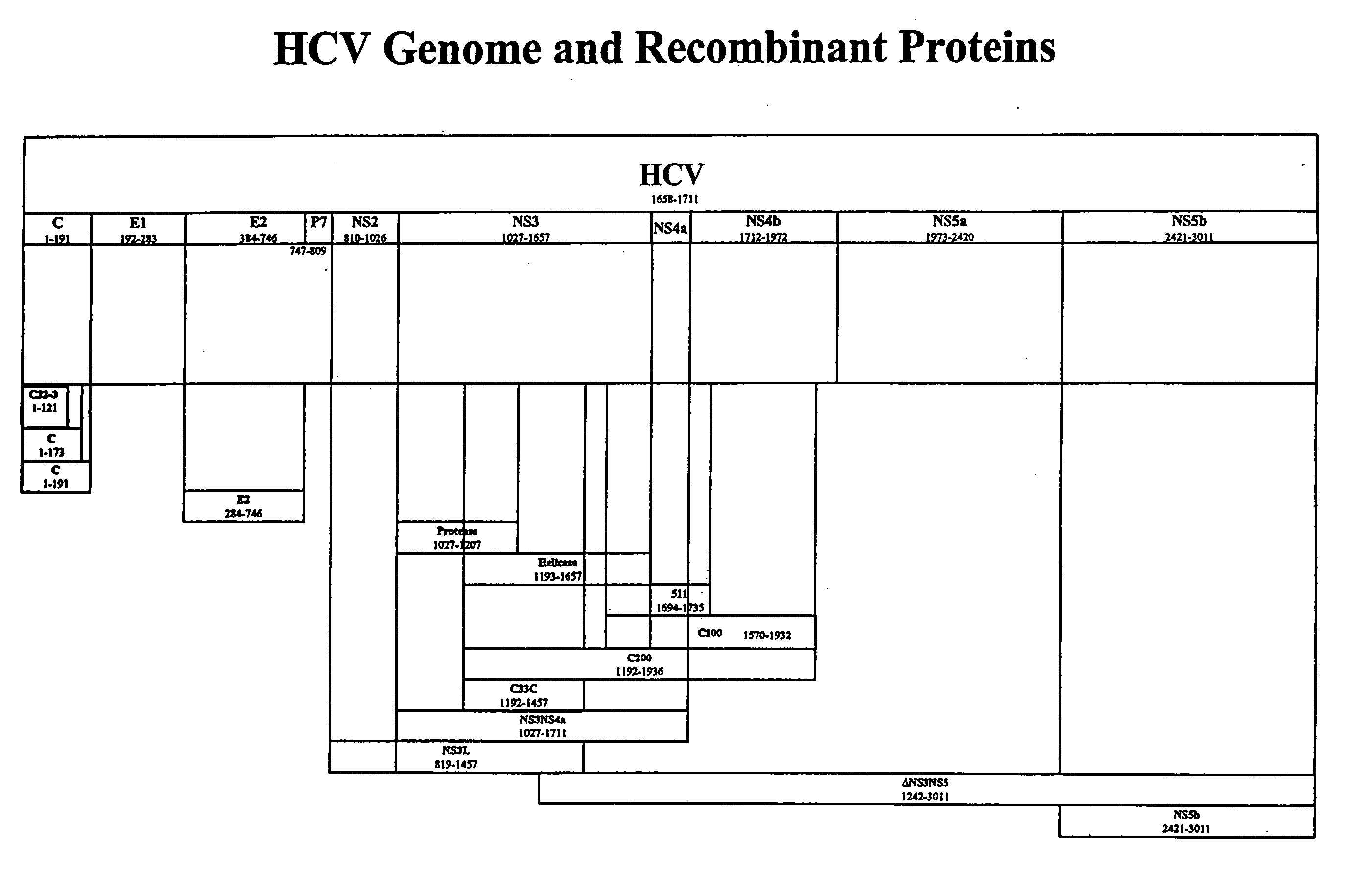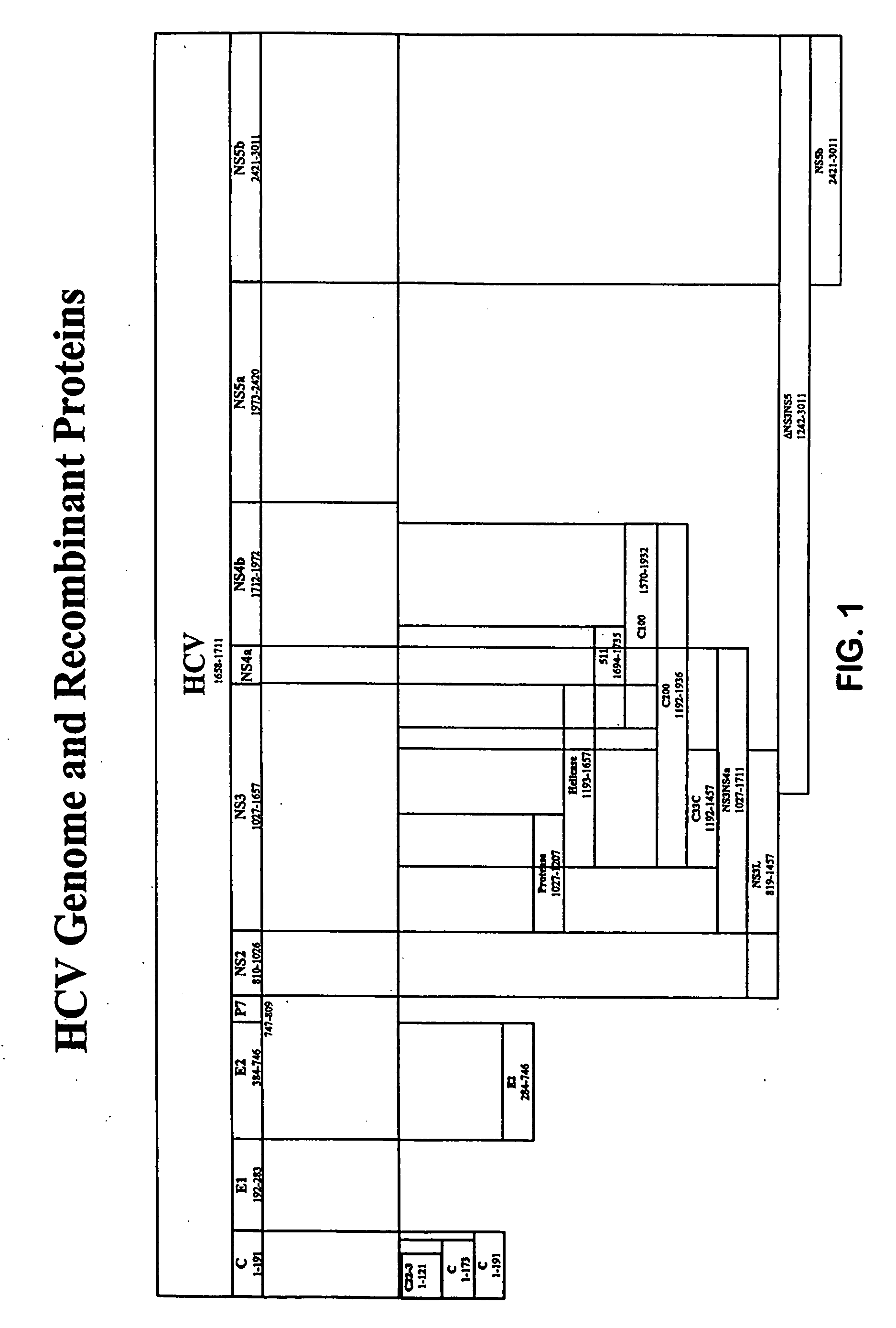Truncated hepatitis C virus NS5 domain and fusion proteins comprising same
a fusion protein and hcv technology, applied in the field of hcv polypeptides, can solve the problems of limited success in the control of acute and chronic hcv infection, cirrhosis, liver failure, etc., and achieve the effect of enhancing the production of an hcv ns5 polypeptide and increasing the amount of i
- Summary
- Abstract
- Description
- Claims
- Application Information
AI Technical Summary
Benefits of technology
Problems solved by technology
Method used
Image
Examples
example 1
[0246] Production of NS5Core and NS5tCore Polynucleotides and Polypeptides
[0247] NS5t in the following examples represents a C-terminally truncated NS5 molecule, that includes amino acids corresponding to amino acids 1973-2990, numbered relative to the full-length HCV-1 polyprotein.
[0248] A polynucleotide encoding NS5t was prepared using standard recombinant techniques and this construct was fused with a polynucleotide encoding a core polypeptide that included amino acids 1-121 of the full-length polyprotein, as depicted at amino acid positions 1772-1892 of FIG. 3, to render NS5tCore121.
[0249] The NS5tCore121 polynucleotide was cloned and expressed in S. cerevisiae. In particular, The NS5Core proteins were genetically engineered for expression in S. cerevisiae using the yeast expression vector pBS24.1. This vector contains the 2μ sequence for autonomous replication in yeast and the yeast genes leu2d and URA3 as selectable markers. The β-lactamase gene and the ColE1 origin of repl...
example 2
Production of NS3*NS4NS5t and NS3*NS4NS5tCore Polynucleotides and Polypeptides
[0253] NS3* in the following examples represents a modified NS3 molecule with an alanine substituted for the serine normally found at position 1165, numbered relative to the full-length HCV-1 polyprotein sequence.
[0254] A polynucleotide encoding NS3NS4 (approximately amino acids 1027 to 1972, numbered relative to HCV-1) (also termed “NS34” herein) is isolated from an HCV. The NS3 portion of the molecule is mutagenzied by mutating the coding sequence for the Ser residue found at position 1165 to the coding sequence for Ala, such that the resulting molecule lacks NS3 protease activity. This construct is fused with the polynucleotide encoding NS5tCore121 described in Example 1, to render NS3*NS4NS5tCore121. Alternatively, this molecule is fused with NS5t to produce NS3*NS4NS5t. The constructs are cloned into plasmid, vaccinia virus, and adenovirus vectors. Additionally, the constructs are inserted into a re...
example 3
Production of E2NS3*NS4NS5t and E2NS3*NS4NS5tCore Polynucleotides and Polypeptides
[0256] E2 in the following examples represents a C-terminally truncated E2 molecule that includes amino acids 384-715, numbered relative to the full-length HCV-1 polyprotein. A polynucleotide encoding the truncated E2 molecule is produced using the methods described in U.S. Pat. Nos. 6,121,020 and 6,326,171, incorporated herein by reference in their entireties. Polynucleotides encoding NS3*NS4NS5tCore121 or NS3*NS4NS5t are produced as described in Example 2. The constructs are fused to render E2NS3*NS4NS5tCore121 and E2NS3*NS4NS5t. The constructs are cloned into plasmid, vaccinia virus, and adenovirus vectors. Additionally, the constructs are inserted into a recombinant expression vector and used to transform host cells to produce the E2NS3*NS4NS5tCore121 and E2NS3*NS4NS5t fusion proteins. Protease enzyme activity is determined as described above.
PUM
| Property | Measurement | Unit |
|---|---|---|
| Length | aaaaa | aaaaa |
| Immunogenicity | aaaaa | aaaaa |
Abstract
Description
Claims
Application Information
 Login to View More
Login to View More - R&D
- Intellectual Property
- Life Sciences
- Materials
- Tech Scout
- Unparalleled Data Quality
- Higher Quality Content
- 60% Fewer Hallucinations
Browse by: Latest US Patents, China's latest patents, Technical Efficacy Thesaurus, Application Domain, Technology Topic, Popular Technical Reports.
© 2025 PatSnap. All rights reserved.Legal|Privacy policy|Modern Slavery Act Transparency Statement|Sitemap|About US| Contact US: help@patsnap.com



